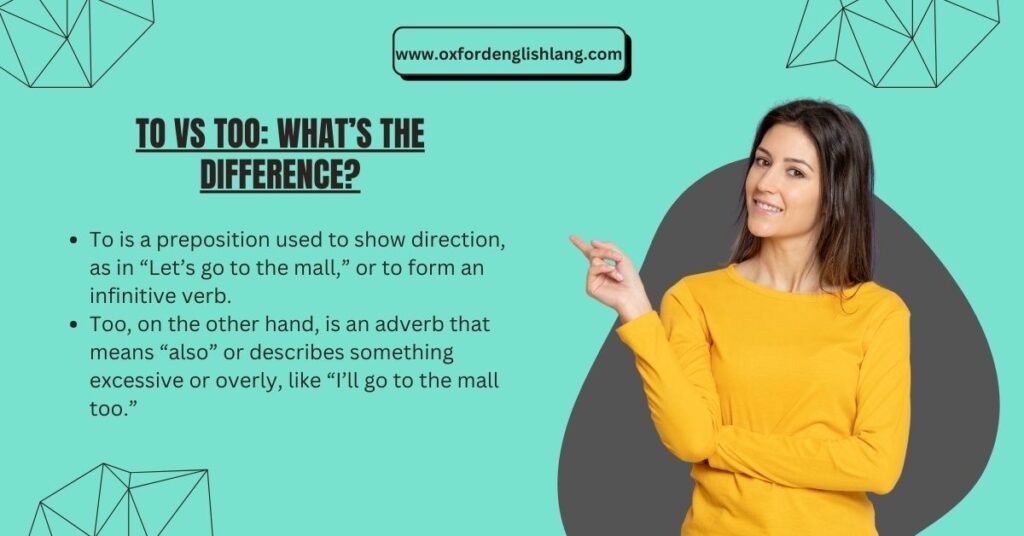Grasping the subtleties of the English language, especially with homophones like to and too, can be tricky. These words often arise in conversations and writing, leading to errors that alter their meanings. The term “to” acts as a preposition, showing direction or forming an infinitive verb, while “too” serves as an adverb to express something excessively or in addition.
For instance, saying, “I am heading to the store” uses to as a preposition, while “The puppy is too cute” emphasizes the cuteness to an extreme level.
Misusing these distinct terms can lead to common mistakes and misunderstandings in both written and spoken communication. As someone who has spent years learning and refining my understanding of language, I’ve discovered that clarifying their roles through examples and scenarios is crucial. For instance, the phrase, “I want to eat,” uses to as part of an infinitive, while “This dessert is too sweet” highlights excessiveness.
To avoid such errors, it’s important to explore the differences between these two words with a practical approach. Using simple tips like identifying whether the word shows direction, forms a verb, or modifies an adjective can help.
Tricks like pairing “to” with actions and “too” with extremes have enhanced my ability to use them effectively. This approach not only builds proficiency but also helps in uncovering the secrets of proper usage.
In my experience, paying attention to context and practicing with specific phrases has made all the difference. Whether you’re a native speaker or someone learning English as a second language, mastering these distinctions is a crucial step in enhancing your abilities. It’s not just about avoiding grammatical errors; it’s about communicating your thoughts clearly and effectively.
Too vs To: What’s the difference?

Too, is an adverb that means “also” or describes something excessive or overly, like “I’ll go to the mall too.”
To, on the other hand is a preposition used to show direction, as in “Let’s go to the mall,” or to form an infinitive verb.
You Might also like: Moment Vs Momment: which one is correct?
Too Cute vs To Cute: What’s the difference?
When deciding between too cute and to cute, it’s important to understand their different functions.
Too is an adverb used to express excess, like in the phrase “This is too much” or “The puppy is too cute,” meaning the cuteness is overwhelming or beyond what’s expected.
On the other hand, to is a preposition that shows direction, location, or position, like in “I am going to the store” or “I want to eat.” If you use “to cute,” it creates confusion because it doesn’t express the intended meaning or degree of cuteness.
The mix-up happens because these words sound the same, but their purposes are completely different. Too indicates excess, while to points to a direction or purpose.
To avoid this confusion, it’s helpful to remember that too often means “also” or “excessively,” like in “She is coming too,” while to is simpler and used for indicating movement or position. The key is to stay focused on the context and function of each word to communicate clearly.
How to use “ to ”

The word to is a preposition that shows direction, movement, or a goal. For example, in the sentence “I am going to the store,” it indicates the location or destination. It also plays a role in forming the infinitive form of a verb, like in “I want to eat.” When you want to express a relationship or attachment, to is used, such as in “This book belongs to me.”
It’s important to remember that to can also indicate a range or a period, like “It will take five to ten minutes.” Understanding the usage of to in different contexts helps avoid confusion, especially when distinguishing it from too, which expresses excess.
You Might also like: Align To or Align With: Which is Correct?
How to use “ too ”
The word too is often used to express excessiveness or to emphasize something in a sentence. For example, you might say, “That puppy is too cute” to indicate that the cuteness is overwhelming. It’s also used in casual speech to mean “also” or “as well,” like in the phrase, “I want to go too.” In some cases, too can confirm the accuracy of a statement, such as saying, “That was too good.” In these situations, too serves as an appropriate choice to express excessiveness or add emphasis.
Just like in any conversation, it’s important to compare too with other words like “also” to ensure it fits the context and sounds natural.
Examples of to vs. too
- I am going to the store to buy some snacks. (direction)
- She is too tired to finish her homework tonight. (excessiveness)
- He gave the book to his friend for her birthday. (giving)
- The cake was too sweet for my taste. (excessiveness)
- I have to finish this project by tomorrow. (obligation)
- The weather was too cold for a walk outside. (excessiveness)
- She needs to speak with the manager about the issue. (action)
- The movie was too long, and I couldn’t stay awake. (excessiveness)
- We’re going to the beach this weekend. (destination)
- The coffee is too hot to drink right now. (excessiveness)
Key Differences Between Too Cute and To Cute
- Too Cute expresses an overwhelming level of adorable cuteness, while To Cute is grammatically incorrect and lacks a clear meaning.
- Too Cute is used to show affection or admiration for something irresistibly cute, like babies or animals, while To Cute does not convey any specific emotion or sentiment.
- The phrase Too Cute is commonly used in informal settings to express how captivating something is, while To Cute has no defined usage in everyday language.
- Too Cute implies a positive emotional response, while To Cute does not express any reaction or emotion.
- Too Cute suggests something that is beyond what is normal in terms of cuteness, while To Cute has no purpose or meaning.
- You can use Too Cute to describe adorable moments, like a heartwarming event or reaction, while To Cute does not fit in these contexts.
- The phrase Too Cute is often used to describe situations or appearances that are excessive in their cuteness, while To Cute doesn’t have a specific connotation.
- Too Cute is a phrase that carries an emotional weight, while To Cute is undefined and does not communicate anything clearly.
- Too Cute can be a compliment, while To Cute does not serve any meaningful purpose in conversation.
- Too Cute can be used to express fondness or joy about something endearing, while To Cute has no clear or recognized meaning.
Examples For “Too Cute”
- The puppy’s little paws are too cute to resist.
- That kitten’s playful antics are just too cute for words.
- The baby’s giggle is too cute, it brightens up my day.
- His attempt to tie his shoes was too cute to ignore.
- The way she smiles when she’s excited is too cute.
- The tiny sweater she wore was too cute for her to handle.
- That baby’s laugh is too cute; it’s contagious.
- The little bird hopping around the yard is too cute to look away from.
- The way the children were playing together was too cute to miss.
- The way he holds his favorite toy is too cute for words.
You Might also like: Performed Vs Preformed: A Simple Yet Powerful Guide
Frequently asked questions
What does “too cute” mean in English?
“Too cute” is used to describe something that is excessively adorable or charming. It emphasizes that the level of cuteness is beyond what is expected or usual, often evoking a strong emotional response.
How is “too” different from “to” when used in phrases like “too cute” and “to cute”?
The word “too” is an adverb that indicates excessiveness or a high degree of something, such as in “too cute.” On the other hand, “to” is a preposition, typically used to show direction, place, or purpose, as in “I am going to the store.” In the phrase “to cute,” “to” is grammatically incorrect because it does not fit the intended meaning.
What tips can help you remember when to use “too cute” over “to cute” in conversations?
To remember when to use “too cute,” think about whether you’re describing something as overly or excessively cute. If the cuteness is beyond normal, “too” is the right choice. Also, practice using “too” in other contexts where it expresses excess, like “too much” or “too hard.”
When would you use “to cute” in a sentence?
“To cute” is not grammatically correct and should not be used in a sentence. The proper phrase is “too cute,” which accurately expresses excessive cuteness.
What is the potential confusion that can arise from using “to cute” instead of “too cute”?
Using “to cute” instead of “too cute” can lead to confusion because it is grammatically incorrect and does not convey the intended meaning. People may not understand the intended excessiveness of the cuteness, and it can make your sentence sound awkward or incomplete.

david Miller is an experienced English language expert with a deep passion for helping others communicate effectively and confidently. With a background in linguistics and literature, He provides clear, accessible insights on grammar, writing, and communication strategies. Through well-researched articles and practical advice, David Miller aims to make language learning both inspiring and achievable for readers of all levels.


